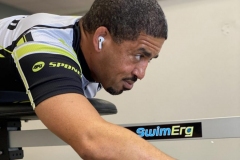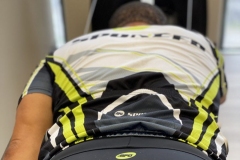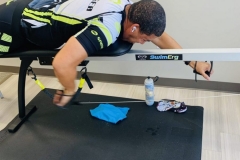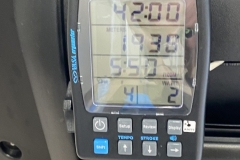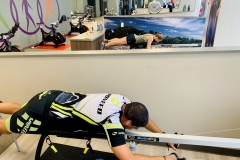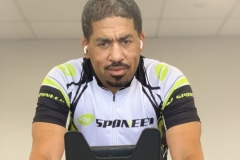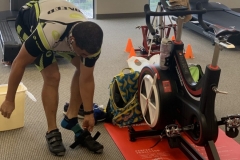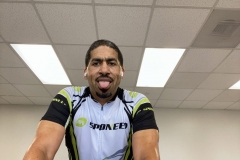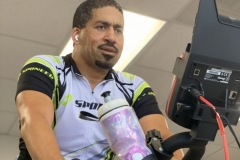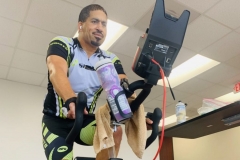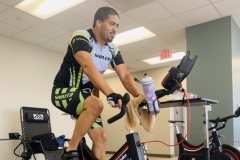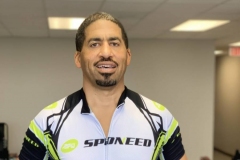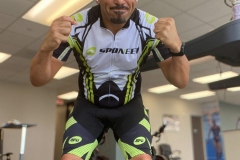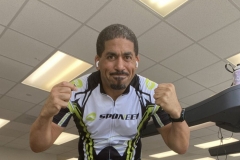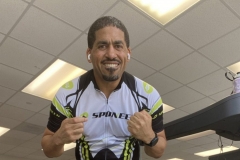Today is Race Day!

Ready to Rock-N-Roll
As I stated in my previous post, my goals were simple and clear:
- 1.2 mile swim in less than 45 minutes
- 56-mile bike ride in less than 3h30min
- 13.1 mile run in less than 2h30min
- focus on executing nutrition strategy and avoiding the “wall” aka “bonking”
- complete the damn thing!
Swimming on dry land
 The VASA swim erg is great for developing technique. But using it as a racing device is not ideal. Lying flat on my stomach and holding my legs up for 40 minutes puts an uncomfortable strain on my back. The way to lessens the discomfort is to push my chest into the bench while swimming.
The VASA swim erg is great for developing technique. But using it as a racing device is not ideal. Lying flat on my stomach and holding my legs up for 40 minutes puts an uncomfortable strain on my back. The way to lessens the discomfort is to push my chest into the bench while swimming.
My plan was not to go all out but to maintain a pace of about 1min55 seconds average. I’ve done 1:55 on the erg before and I knew that it was sustainable. I also knew that my shoulders would get fatigued but that I should be able to maintain without resting.
I composed myself, set my watch, and began. Although confident that I could complete the day, I was nervous and uncertain about how hard I could and should push myself. In the end, I decided not to have an easy day, but I wouldn’t treat it like a “real” race, redline, and push myself to the limit. Instead, I chose to practice maintaining goal pacing, power output (energy expenditure), and nutrition timing (refueling). All three of these race components are critical if I am going to complete a full Ironman. So, now is an ideal opportunity to assess all three.
Surprisingly, I completed the swim faster than expected. I did become tired and the position became very uncomfortable about 2/3 the way through, but I focused on my pace and stroke. I also tried to prevent my mind from wandering, instead, remaining focused on the execution of each stroke…strong pull back with full extension, then lift my elbow and recover quickly while beginning the pull on the other side. That was my job for 40 minutes… nothing else. Staying focused on only that was very difficult.

56 miles of cycling to nowhere

In a normal race, the span of time between the swim and the bike is called T1 or transition 1. Typically, the exit from the water is not close to the bike area and we end up jogging (or walking) to get there. Today, I jumped off of the swim erg and took a few steps over to the bike. I went to the restroom and then leisurely put on my cycling gear.
The bike is when my nutrition plan really becomes important. The bike is the longest portion of the race and we have to maintain sufficient energy to get off of it and be able to run for a while (half-marathon today). In addition to adequate energy stores, we have to keep our muscles from cramping up. This typically occurs with depleted energy reserves as well as dehydration or loss of electrolytes. In Texas, excessive fluid loss due to sweating is a significant threat. So, combined with taking sufficient calories, I have to remember to constantly drink fluids and take in salt to replenish what’s being lost in my sweat. I try to take in 1 gram of sodium per hour during the bike and run. Of course, I also supplement magnesium, calcium, and potassium.
Exit T1
I filled two bottles with Infinit hydration mix, took one AltRed tablet, and placed my BASE salt container in the Bento box on my bike. My watch was set to remind me to drink every 10 min (the goal was to consume a bottle every hour), and take a few licks of salt every 30 minutes. All the while keeping an eye on my power, making sure that I don’t get overly enthusiastic and push higher than 186 Watts. Anything above 186W and my body will cross my lactate threshold and reduce the utilization of fats (free fatty acids). I will also unnecessarily increase my heart rate and burn energy faster than necessary.
An Ironman (for non-professional athletes) is not about who finishes the fastest, it’s who slows down the least. We train to increase our ability to go faster with less energy usage…building a bigger base or building a bigger engine.
The first thirty miles felt long. The seat on the Wattbike was unfamiliar and uncomfortable. Part of the discomfort was the thinner padding in the tri-suit. I always train in bike shorts which have 2x the padding. I was maintaining good power and my pace was faster than expected, about 20 MPH. Somewhere around 45 miles, I began to feel the fatigue in my thighs. I began taking the salts more frequently since I was sweating profusely. That seemed to help. I shattered my expectations by completing 56 miles in 2h 51min and I got off the bike feeling strong.
Transition-2 (T2) is the time between exiting the bike and beginning the run. I just went to the restroom and refilled my water bottles with Infinit run blend. I planned to consume one bottle per hour while taking salts every 20-30 minutes.
Time to face my boogie monster – the half-marathon
Although I felt strong and my legs were not fatigued as they’ve been in past races, I haven’t yet conquered my overwhelming sense of inadequacy as a runner. Meaning, I don’t doubt that I can run a half marathon, I doubt that I can hold a good pace and push myself for that distance. I haven’t “proven” my ability to myself in the same way that I’ve proven my ability to ride and swim harder for long durations.
I set the treadmill to a 1% incline and a pace of 11 minutes/mile. Shortly after I began, Johnny told me to run a mile and walk a mile and do the distance that way. Something about that felt wrong. I agreed with a head-nod and then he waved goodbye…”let me know when you’ve completed the run” was the last thing I heard him say.
I knew that I needed to run the entire distance, or at least attempt to run it. Run-walk was not going to leave me feeling satisfied with my effort. This is my first half-ironman after all.
Unlike a sanctioned race, I listened to music to pass the time. In addition, my whole team at work was texting me messages of encouragement. I was feeling strong and supported, no need to walk! The first two miles felt a little stiff, my legs were still in “cycling” mode. Once the blood flow adapted and the muscles woke up, the run felt much more fluid. I stopped a couple of times to set up the tripod and my camera to snap some pics (everyone was gone at this point). Other than that, I continued jogging at a comfortable pace. Around the 8th mile, I felt my legs begin to get heavy. Maintaining the pace required more effort. I didn’t want to slow down or walk.
Mile 10 – I felt like stopping and walking. I didn’t.
Mile 11 – I had to tell my mind to shut the fuck up, I will not stop running until I’m done.
Mile 12 – Hip flexors and Iliotibial (IT) band joined the hurt-party 😣
The distance from mile 12 to 13.1 – felt like 4 miles 😳 … the struggle was enormous
… And worth every step!
Done!
Exhausted and delighted are perfect descriptors of how I felt immediately after I finished.
I couldn’t bend over for the risk of passing out, so I slammed a few light beers and two recovery pouches.
After 30 minutes of standing up and waiting for my body to return to normal, I collected my gear and drove home feeling like a winner.

70.3 distance triathlon…Accomplished!
After diligently training for over a year, I completed it. Although the race was not run as I’d planned, I am 100% happy with myself and what I did today.

